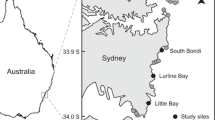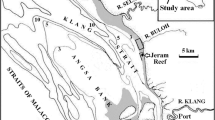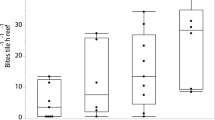Abstract
Previous work with planktivorous fishes has shown that they import particulate organic and inorganic material to reefs in the form of fecal pellets, which, in part, are deposited in crevices on the reef where these fishes shelter during their inactive period. Since these feces do not accumulate in fish shelters, we predicted that some of the feces could be rapidly consumed by reef detritivores. We examined the attractiveness of fish feces to potential reef detritivores by placing traps baited with planktivorous fish feces, along with unbaited control traps, in crevices on rocky reefs at Santa Catalina Island, California, USA, between June 1982 and November 1983, and on coral reefs at St. Croix, U.S. Virgin Islands, during June 1983. Significantly more animals (the majority being crustaceans) were trapped in the baited traps compared to the unbaited controls on both reefs. There was also a significant association between the presence of trapped animals and fish feces at Santa Catalina Island (p = 0.009); this association was not quite as strong in St. Croix (p = 0.069). The consumption by shrimp of feces marked with carmine particles and, in turn, the predation on these shrimp by a reef fish demonstrates the links between this type of imported particulate organic and inorganic material and the food web of the reef community.
Similar content being viewed by others
Literature cited
Adams, S. M., Angelovic, J. W. (1970). Assimilation of detritus and its associated bacteria by three species of estuarine animals. Chesapeake Sci. 11: 249–254
Bailey, T. G., Robertson, D. R. (1982). Organic and caloric levels of fish feces relative to its consumption by coprophagous reef fishes. Mar. Biol. 69: 45–50
Barr, L. (1971). Observations on the biology and behavior of the arrow crab,Stenorynchus seticornix (Herbst), in Lameshur Bay, St. John, Virgin Islands. In: Miller, J. W., Van Derwalker, J. G., Waller, R. A. (eds.) Scientists in the sea. U.S. Department of the Interior, Washington, D.C., p. 213–220
Bray, R. N., Miller, A. C. (1983). Role of planktivorous fishes as nutrient importers into a tropical reef community. Final Report on Hydrolab mission 83-7. Office of Undersea Research NOAA, U.S. Department of Commerce, Washington, D.C.
Bray, R. N., Miller, A. C. (1985). Planktivorous fishes: their potential as nutrient importers to artificial reefs. (Abstract) Bull. mar. Sci. 37: p. 396
Bray, R. N., Miller, A. C., Cailliet, G., Geesey, G. C., Kopczak, C., Norcross, C., Grober, M. (1982). Role of planktivorous fishes as nutrient importers into a tropical reef community. Final report on Hydrolab mission 82-3. Office of Undersea Research, NOAA, U.S. Department of Commerce, Washington, D.C.
Bray, R. N., Miller, A. C., Geesey, G. G. (1981). The fish connection: a trophic link between planktonic and rocky reef communities. Science, N.Y. 214: 204–205
Bray, R. N., Purcell, L. J., Miller, A. C. (1986). Ammonium excretion in a temperate-reef community by a planktivorous fish,Chromis punctipinnis (Pomacentridae), and potential uptake by young giant kelp,Macrocystis pyrifera (Laminariales). Mar. Biol. 90: 327–334
Fager, E. W. (1971). Pattern in the development of a marine community. Limnol. Oceanogr. 16: 241–253
Faulkner, D., Chesher, R. (1979). Living corals. Crown Publishers, New York
Frankenberg, D., Smith, K. L., Jr. (1967). Coprophagy in marine animals. Limnol. Oceanogr. 12: 443–450
Geesey, G. G., Alexander, G. V., Bray, R. N., Miller, A. C. (1984). Fish fecal pellets are a source of minerals for inshore reef communities. Mar. Ecol. Prog. Ser. 15: 19–25
González, H., Biddanda, B. (1990). Microbial transformation of metazoan (Idotea granulosa) faeces. Mar. Biol. 106: 285–295
Hamner, P., Hamner, W. M. (1977). Chemosensory tracking of scent trails by the planktonic shrimp,Acetes sibogae australis. Science, N.Y. 195: 886–888
Hamner, W. M., Jones, M. S., Carleton, J. H., Hauri, I. R., Williams, D. McB. (1988). Zooplankton, planktivorous fish, and water currents on a windward reef face: Great Barrier Reef, Australia. Bull. mar. Sci. 42: 459–479
Hobson, E. S. (1973). Diel feeding migrations in tropical reef fishes. Helgoländer wiss. Meeresunters. 24: 361–370
Hobson, E. S., Chess, J. R. (1976). Trophic interactions among fishes and zooplankters nearshore at Santa Catalina Island, California. Fish. Bull. U.S. 74: 567–598
Johannes, R. E., Satomi, M. (1966). Composition and nutritive value of fecal pellets of a marine crustacean. Limnol. Oceanogr. 11: 191–197
Kopczak, C. D. (1983). Spatial and temporal variation in the flux of particulate organic material in a kelp bed. Master thesis. California State University, Long Beach, USA
Lampitt, R. S., Noji, T., von Bodungen, B. (1990). What happens to zooplankton faecal pellets? Implications for material flux. Mar. Biol. 104: 15–23
Meyer, J. L., Schultz, E. T., Helfman, G. S: (1983). Fish schools: an asset to corals. Science, N.Y. 220: 1047–1049
Ogden, J., Buckman, N. S. (1973). Movement, foraging groups, and diurnal migrations of the striped parrotfish,Scarus croicensis Block (Scaridae). Ecology 54: 589–596
Polunin, N. V. C. (1988). Efficient uptake of algal production by a single resident herbivorous fish on the reef. J. exp. mar. Biol. Ecol. 123: 61–76
Polunin, N. V. C., Koike, I. (1987). Temporal focusing of nitrogen release by a periodically herbivorous reef fish. J. exp. mar. Biol. Ecol. 111: 285–296
Robertson, D. R. (1982). Fish feces as fish food on a Pacific coral reef. Mar. Ecol. Prog. Ser. 7: 253–265
Sokal, R. R., Rohlf, F. J. (1981). Biometry. The principles and practice of statistics in biological research. 2nd ed. W. H. Freeman & Co., San Francisco
Steinberg, P. D. (1985). Feeding preferences ofTegula funebralis (Gastropoda) on marine brown algae: effects of phenolic compounds, nitrogen content, and algal toughness. Ecol. Monogr. 55: 333–349
Stuart, V., Newell, R. C., Lucas, M. I. (1982). Conversion of kelp debris and faecal material from the mussel,Aulacomya ater, by marine microorganisms. Mar. Ecol. Prog. Ser. 7: 47–57
Tenore, K. R., Hanson, R. B., Dornseif, B. E., Weiderhold, C. W. (1979). The effect of organic nitrogen supplement on the utilization of different sources of detritus. Limnol. Oceanogr. 24: 350–355
Youngbluth, M. J. (1982). Utilization of a fecal mass as food by the pelagic mysis larva of the penaeid shrimpSolenocera atlantidis. Mar. Biol. 66: 47–51
Author information
Authors and Affiliations
Additional information
Communicated by M.G. Hadfield, Honolulu
Please address all correspondence and requests for reprints to Dr. Miller at California State University, Long Beach
Rights and permissions
About this article
Cite this article
Rothans, T.C., Miller, A.C. A link between biologically imported particulate organic nutrients and the detritus food web in reef communities. Mar. Biol. 110, 145–150 (1991). https://doi.org/10.1007/BF01313101
Accepted:
Issue Date:
DOI: https://doi.org/10.1007/BF01313101




